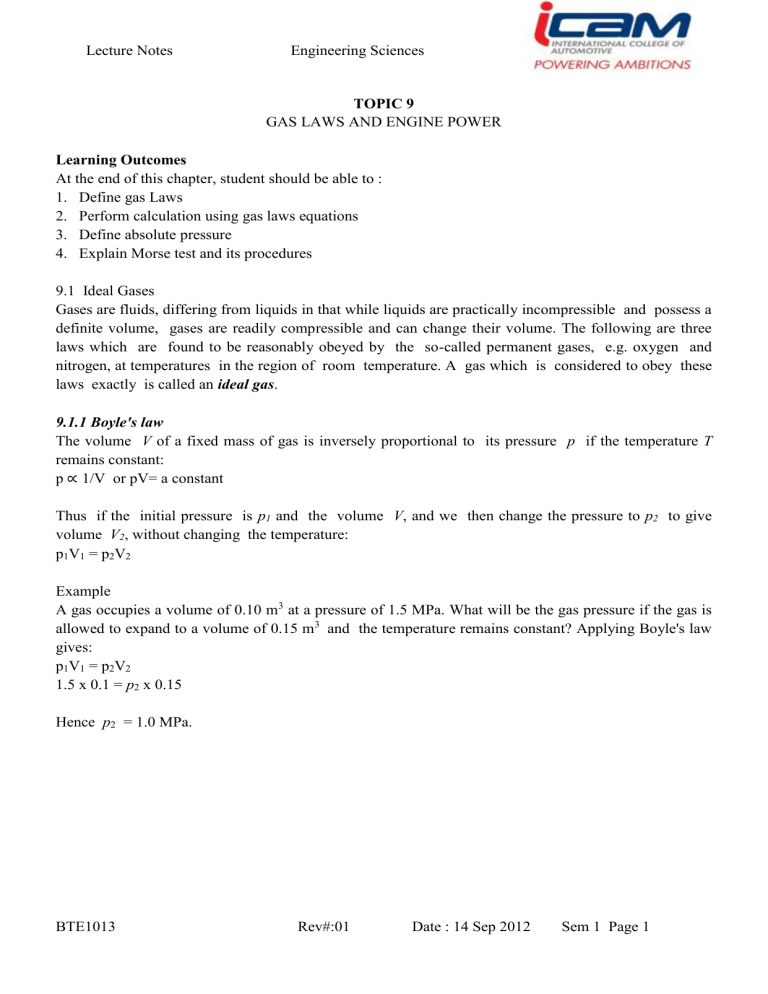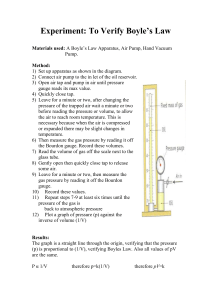LECTURE NOTES BTE1013 GAS LAWS AND ENGINE POWER

Lecture Notes Engineering Sciences BTE1013
TOPIC 9
GAS LAWS AND ENGINE POWER
Learning Outcomes
At the end of this chapter, student should be able to :
1.
Define gas Laws
2.
Perform calculation using gas laws equations
3.
Define absolute pressure
4.
Explain Morse test and its procedures
9.1 Ideal Gases
Gases are fluids, differing from liquids in that while liquids are practically incompressible and possess a definite volume, gases are readily compressible and can change their volume. The following are three laws which are found to be reasonably obeyed by the so-called permanent gases, e.g. oxygen and nitrogen, at temperatures in the region of room temperature. A gas which is considered to obey these laws exactly is called an ideal gas .
9.1.1 Boyle's law
The volume V of a fixed mass of gas is inversely proportional to its pressure p if the temperature T remains constant: p ∝ 1/V or pV= a constant
Thus if the initial pressure is p
1
and the volume V , and we then change the pressure to p
2
to give volume V
2
, without changing the temperature: p
1
V
1
= p
2
V
2
Example
A gas occupies a volume of 0.10 m 3 at a pressure of 1.5 MPa. What will be the gas pressure if the gas is allowed to expand to a volume of 0.15 m
3
and the temperature remains constant? Applying Boyle's law gives: p
1
V
1
= p
2
V
2
1.5 x 0.1 = p
2
x 0.15
Hence p
2
= 1.0 MPa.
BTE1013 Rev#:01 Date : 14 Sep 2012 Sem 1 Page 1
Lecture Notes Engineering Sciences BTE1013
9.1.2 Charles' law
The volume V of a fixed mass of gas at constant pressure is proportional to the temperature T when the temperature is on the Kelvin scale (K):
Thus if initially we have a volume V
1
at a temperature T
1
and we then, without changing the pressure, change the temperature to T
2
to give a volume V
2
:
Example
A gas occupies a volume of 0.12 m
3
at a temperature of 20°C. What will be its volume at 100°C if the gas is allowed to expand to maintain a constant pressure?
Using Charles's law and V
1
/ T l
= V
1
/ T
2
, with T
1
= 20 + 273 = 293 K and T
2
= 100 + 273 = 373 K:
Hence V
2
= 0.11 m
3
.
9.1.3 Pressure law
The pressure p for a fixed mass of gas at constant volume is proportional to the temperature T on the absolute or Kelvin scale:
Thus if initially we have a pressure p
1
at a temperature T l
and we then, without changing the volume, change the temperature to T
2
to give a pressure p
2
:
Example
A fixed volume of gas is initially at a pressure of 140 kPa at 20°C. What will be its pressure if the temperature is increased to 100°C without the volume changing?
Using the pressure law p
1
/ T
1
= p
2 /
T
2
with T
1
= 20 + 273 = 293 K and T
2
= 100 + 273 = 373 K:
Hence p
2
= 178 kPa.
9.1.4 Characteristic gas equation (general gas laws)
Provided there is no change in the mass of a gas, we can combine Boyle's law, Charles's law and the pressure law to give the general equation:
→
BTE1013 Rev#:01 Date : 14 Sep 2012 Sem 1 Page 2
Lecture Notes Engineering Sciences BTE1013
When 1 kg of gas is considered, the constant is called the characteristic gas constant and denoted by R.
Its value depends on the gas concerned. For a mass m kg of gas, the constant has the value mR, hence:
The SI unit of R is thus (Pa x m
3
)/(K x kg) = (N/m
2
x m
3
)/(K x kg) = (N x m)/(K x kg) = J/(kg x K).
Typical values for the characteristic gas constant R are oxygen= 260 J kg
-1
K
-1
, hydrogen= 4160 J kg
-1
K
-1
and air= 287 J kg
-1
K
-1
.
Example
A gas has a volume of 0.10 m
3
at a pressure of 100 kPa and a temperature of 20°C. What will be the temperature of the gas when it is compressed to a volume of 0.04 m
3
by a pressure of 500 kPa?
For an ideal gas p
1
V
1
/ T
1
= p
2
V
2
/T
2
so:
Hence T
2
= 586 K = 313°C.
9.2 Absolute pressure, gauge presure
Absolute Pressure is the sum of the available atmospheric pressure and the gauge pressure in the pumping system:
Absolute Pressure(PSIA) = Gauge Pressure + Atmospheric Pressure e.g. Absolute Pressure = 150 PSIG (Gauge Pressure) + 14.7 PSI(Atmospheric Pressure) = 164.7 PSIA
There are are two kinds of references to measure pressure the gauge pressure and the absolute pressure.
The absolute pressure is measured relative to the absolute zero pressure. Absolute pressure, is pressure that would occur at absolute vacuum, or zero pounds per square inch (PSI). All calculations involving the gas laws require pressure, and temperature, to be in absolute units. Absolute pressure is also referred to as
‘total systems pressure’. To distinguish it from gauge pressure, the term ‘abs’ is usually placed after the unit.
Atmospheric pressure may vary, depending on many factors, such as locality. Altitude and temperature are essential factors. The standard atmospheric pressure (1 atm) is about 14.7 psi.
Absolute Pressure
The absolute pressure - pabs - is measured relative to the absolute zero pressure - the pressure that would occur at absolute vacuum. All calculation involving the gas laws requires pressure (and temperature) to be in absolute units.
Gauge Pressure
A gauge is often used to measure the pressure difference between a system and the surrounding atmosphere. This pressure is often called the gauge pressure and can be expressed as
BTE1013 Rev#:01 Date : 14 Sep 2012 Sem 1 Page 3
Lecture Notes Engineering Sciences BTE1013 p g
= p s
- p atm
(2) where p g
= gauge pressure , p s
= system pressure, p atm
= atmospheric pressure
9.3 Morse test
Frictional losses in the engine bearings, the valve train and, the piston and piston rings are the main causes of the power loss that makes the brake power of an engine smaller than the indicated power. The
Morse test is an engine test that gives an approximate value for the frictional losses and which also provides an approximate value for the indicated power of a multi-cylinder engine. The Morse test is conducted at constant engine speed on a dynamometer. The first phase of the test records the brake power of the engine when all cylinders are firing. Subsequently, one cylinder is prevented from firing and the dynamometer load is adjusted to bring the engine up to the same speed as it was when all cylinders were firing, the brake power then being recorded. The difference between brake power with all cylinders working and that obtained when one cylinder is cut out is the indicated power of the cylinder that is not working. This procedure is repeated for each of the cylinders and the indicated power for the whole engine is the sum of the power of the individual cylinders. A typical Morse test calculation is shown below:
Example
The results shown in Table 14.1 were obtained when a Morse test was conducted on a 4-cylinder petrol engine.
Solution
The total indicated power = sum of each ip of the individual cylinders
Total ip = 19+20+17+18 = 74 kW
Hence,
If we are testing a multi-cylinder engine an alternative method for estimating the Indicated Work/cycle
(and hence the Mechanical Efficiency) consists of cutting out each cylinder in turn & measuring the shaft power, keeping the engine speed the same.
It is based on the assumption that:-
Output power = Indicated power - Friction power
THANK YOU
BTE1013 Rev#:01 Date : 14 Sep 2012 Sem 1 Page 4




